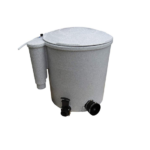Dealing with Eye Damage
 The ‘cleaning process’  The ‘protective stages ’following the application of ‘Clear eye’ |
When dealing with injuries close to the eye, it is best to sedate the Koi several ‘planes’ to avoid any sudden movement causing further damage, and to allow cleaning of the wound.After sedation and before undertaking any work, coat the eye by applying drops of a protective solution of ‘Clear Eye’ or similar. This will provide a waterproof barrier and help to protect the eye from any ‘splashes’ from the subsequent coats.
As in the treatment of all wounds and ulcerations, thoroughly clean the affected area removing all detritus and necrotic tissue. Apply a bactericide and waterproof top coat as described previously. A sight test can be given to ascertain the status of the vision. |
Dealing with Fin Damage
 Inspecting the damaged dorsal fin  Gentley trimming the necrotic tissue  Coating the damage site  Drying treatments using a small fan |
Fin Rot, which I said earlier is a general term for the loss of fin tissue. If left untreated, chronic fin rot can erode the entire tissue away back to the body creating more serious infection and putting your Koi at risk. The damage is can be caused by several bacteria, more commonly Aeromonas & Pseudomonas and is often onset by stress.
Minor damage can be dealt with without sedation. However, for extensive damage, anaesthise the Koi, examine carefully, and trim back the damaged area to clean tissue, removing all necrotic material. Try to avoid removing the ‘leading ray’ on the fin if possible, as this will not re-generate. Other areas can be substantially trimmed as these will ‘grow back’ in a few months provided the water quality (as with any healing process) is good. Unfortunately, trimming is often required as putting a few ‘dabs’ of medication on affected areas will not stop the rotting process. Following the trimming back to clean tissue, we usually coat the adjacent area and trim-line using very strong potassium permanganate solution using a cotton bud. The treatment solution is made up in a small bottle using a small amount of PP crystals mixed with a few drops of pond water (as strong as possible). The potassium permanganate solution will act as both a cauterise to stem any minor blood seepage and a bactericide. Do not use this treatment for body damage and ulcerations as the cauterising properties may cause enlargement of the site. Should Chronic fin rot be present and the damage has extended into the abdomen causing infection, the use on an antibiotic may be required. Seek qualified assistance. Finally, during the course of any ‘coating procedure’, a small battery operated electric fan is an extremely useful to assist drying of the layers. |


